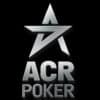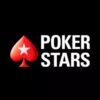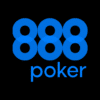Hand reading skills are crucial for any poker player, especially beginners. Being able to assess your opponents’ hand ranges accurately can give you a significant advantage at the poker table. By understanding the cards your opponents are likely to hold, you can make more informed decisions and increase your chances of winning.
The goal of this article is to provide a comprehensive guide for beginner poker players to master hand-reading skills. Whether you’re new to the game or looking to improve your hand-reading abilities, this guide will equip you with the necessary knowledge and techniques to analyze your opponents’ hands effectively.
Mastering hand reading skills is a continuous process that requires practice, observation, and analysis. By developing these skills, you can make better decisions based on the information available to you, ultimately improving your overall poker strategy.

Understanding Hand Reading in Texas Hold’em
In the game of Texas Hold’em, hand reading is the process of deducing the possible cards that your opponents may hold based on their actions, betting patterns, and the community cards on the table. It is a fundamental skill that every poker player should strive to develop.
Hand reading is significant in Texas Hold’em because it allows you to make informed decisions and strategize accordingly. By accurately assessing your opponents’ hand ranges, you can determine the strength of your own hand and adjust your betting and playing accordingly.
One of the critical concepts in hand reading is understanding hand ranges. A hand range refers to the range of possible hands an opponent may have based on their actions and the community cards on the table. It is important to note that a hand range is not a specific hand but rather a range of possible hands.
For example, if an opponent raises pre-flop, their hand range may consist of premium hands like pocket aces or kings, as well as strong-suited connectors like Ace-King or King-Queen. As the hand progresses and more community cards are revealed, the hand range can narrow down based on the available information.
Understanding different hand ranges and their characteristics is essential for effective hand reading. Here are some examples of common hand ranges:
| Hand Range | Characteristics |
|---|---|
| Tight Range | Consists of strong hands and premium pocket pairs |
| Loose Range | Includes a wide range of hands, including weaker holdings |
| Polarized Range | Combines very strong hands with weaker speculative hands |
| Bluff Range | Contains hands that are unlikely to win but are used for bluffing |
By familiarizing yourself with these different hand ranges, you can start to make more accurate assumptions about your opponents’ likely holdings. This knowledge will help you make better decisions throughout the hand.
To further illustrate the concept of hand ranges, take a look at the following hand range chart:

This chart visually represents the different hand ranges that players may have in a given situation. It provides a general guideline for understanding the likelihood of certain hands based on the player’s position and the stage of the hand.
By referring to this chart and considering the specific circumstances of the hand, you can begin to narrow down your opponents’ hand ranges and make more informed decisions.
Poker Hand Reading Techniques
Hand reading in poker involves utilizing various techniques to gather information and make educated assumptions about your opponents’ likely hand ranges. By understanding these techniques, you can improve your ability to accurately assess your opponents’ holdings and make better decisions at the poker table.
One of the most essential aspects of hand reading is observing your opponents’ actions and behaviors. Paying close attention to how they bet, raise, or check can provide valuable insights into the strength of their hands. For example, if an opponent suddenly increases their bet size, it could indicate a strong hand, while a hesitant check might suggest weakness.
Another technique used in hand reading is narrowing down an opponent’s hand range. This process involves analyzing the available information and eliminating unlikely hands from their range. As the hand progresses and more community cards are revealed, you can refine your assessment and make more accurate assumptions about their holdings.
Range-based thinking is a common hand-reading technique that involves considering the entire range of hands an opponent could have in a given situation. Instead of focusing on a specific hand, you analyze the likelihood of different hands within their range. This approach allows you to make more informed decisions based on the overall strength of their range rather than a single hand.
A street-by-street analysis is another effective hand-reading technique. It involves evaluating an opponent’s hand range at each stage of the hand, taking into account the community cards and their actions. By considering how their range might have changed from the pre-flop to the flop, turn, and river, you can make more accurate predictions about their likely holdings.
To illustrate the process of narrowing down a hand range, take a look at the following image:
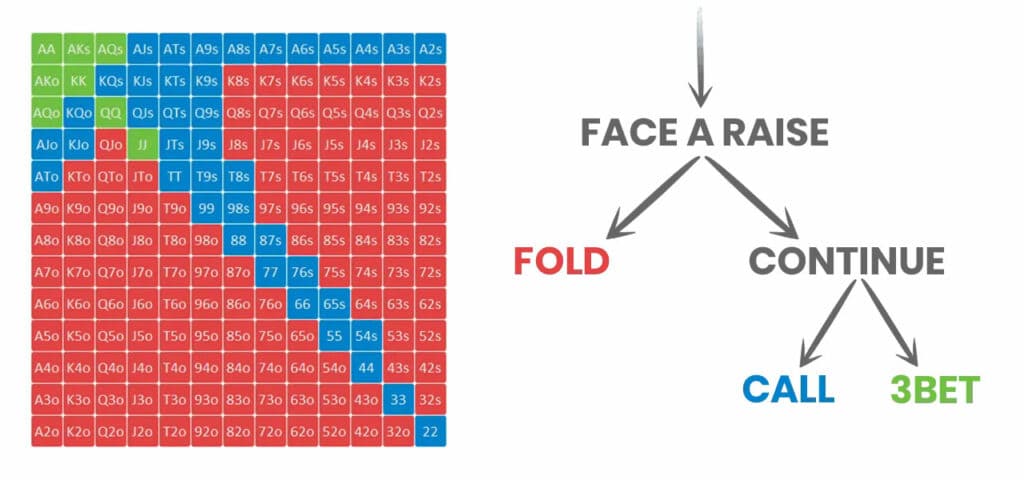
This image demonstrates the step-by-step process of narrowing down an opponent’s hand range. Starting with a wide range of possible hands, you gradually eliminate unlikely holdings based on their actions and the community cards. By the river, you can make a more accurate assessment of their likely hand.
By incorporating these hand reading techniques into your poker strategy, you can gain a significant advantage over your opponents. Remember to observe their actions and behaviors, narrow down their hand range, and utilize range-based thinking and street-by-street analysis. With practice and experience, your hand-reading skills will continue to improve, allowing you to make more informed decisions and increase your chances of success at the poker table.
Advanced Hand Reading Concepts
Once you have a solid foundation in hand reading, you can further enhance your skills by incorporating advanced concepts into your analysis. These concepts will allow you to gain a deeper understanding of your opponents’ hand ranges and make more accurate predictions about their likely holdings.
One important concept to consider is board texture. The texture of the community cards can significantly impact the range of hands that your opponents are likely to have. For example, a coordinated and connected board with multiple potential draws will widen the range of hands that your opponents could be holding. On the other hand, a dry and uncoordinated board will narrow their range. By analyzing the board texture, you can make more precise assumptions about the strength of your opponent’s hands.
Another advanced concept in hand reading is the use of blockers. Blockers are cards you hold in your hand that make it less likely for your opponents to have specific combinations of cards. For example, if you hold the Ace of spades, it reduces the likelihood that your opponent has a flush draw with the Ace of spades in their hand. By understanding the concept of blockers, you can narrow down your opponents’ hand ranges and make more accurate assessments of their likely holdings.
Understanding bet sizing is also crucial for effective hand reading. The size of your opponents’ bets can provide valuable information about the strength of their hands. For example, a small bet may indicate a weak hand or a bluff, while a large bet may suggest a strong hand. By paying attention to bet sizing, you can gain insights into your opponents’ hand ranges and adjust your strategy accordingly.
To illustrate the concept of blockers, take a look at the following image:
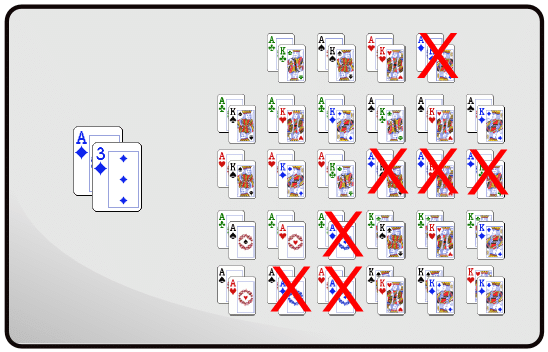
This image demonstrates how blockers can narrow down your opponents’ hand ranges. In this example, the player holds the Ace of Hearts and the King of Hearts, which reduces the likelihood of their opponent having a strong flush draw. By considering the blockers, the player can make a more accurate assessment of their opponent’s likely holdings.
By incorporating these advanced hand reading concepts into your analysis, you can elevate your poker game to a new level. Consider the board texture, utilize blockers to narrow down hand ranges, and pay attention to bet sizing. These techniques will enhance your ability to read your opponents’ hands and make more informed decisions at the poker table.
Developing Hand Reading Skills
Developing hand reading skills is a continuous process that requires practice, experience, and a deep understanding of the game. By following practical tips and strategies, you can improve your hand reading accuracy and make more informed decisions at the poker table.
One of the most important aspects of developing hand reading skills is practice. The more you play and actively engage in hand reading, the better you will become. Take every opportunity to analyze your opponents’ actions and think about their likely hand ranges. Over time, you will start to recognize patterns and make more accurate assessments.
Experience is also crucial in improving hand reading accuracy. The more hands you play and the more situations you encounter, the better you will become at reading your opponents. As you gain experience, you will develop a better intuition and be able to make quicker and more accurate decisions based on the information available to you.
In addition to practice and experience, there are specific exercises and drills that can help enhance your hand reading abilities. Here are a few suggestions:
- Hand Range Guessing: Take a hand history from a previous game and try to guess the hand range of each player involved. Compare your guesses with the actual hands and analyze any discrepancies.
- Hand Reading Scenarios: Create hypothetical hand reading scenarios and analyze them. Consider the actions, bet sizing, and board texture to make an educated guess about your opponents’ likely hand ranges.
- Hand Reading Exercises: Participate in hand reading exercises with fellow poker players. Discuss and analyze different hand scenarios to gain insights and perspectives from others.
By regularly practicing these exercises and drills, you can sharpen your hand reading skills and improve your ability to assess your opponents’ likely holdings accurately.
Let’s take a look at an example hand reading scenario:
Scenario: You are playing in a No-Limit Texas Hold’em cash game. The player to your right raises preflop, and you decide to call with pocket Jacks. The flop comes with 9 of hearts, 7 of diamonds, and 2 of clubs. The initial raiser bets half the pot. What could be their likely hand range?
In this scenario, you can analyze the situation by considering the player’s preflop raising range, the flop’s texture, and their post-flop betting. Based on their preflop raise, their range could include hands like Ace-King, Ace-Queen, or pocket pairs. The flop texture is relatively low and disconnected, which may not favor their range. Their post-flop bet sizing could indicate a continuation bet with a wide range of hands or a strong hand trying to extract value.
By analyzing hand reading scenarios like this, you can develop a systematic approach to assessing your opponents’ likely hand ranges and making more informed decisions.
To further enhance your hand reading skills, here is an video showcasing a hand reading exercise:
This exercise involves analyzing the actions, bet sizing, and board texture to determine the likely hand range of your opponent. By practicing exercises like this, you can improve your ability to read your opponents’ hands and make more accurate decisions at the poker table.
Analyzing Opponent’s Hand Range
When playing poker, analyzing your opponent’s hand range is a crucial skill that greatly impacts your decision-making process. By understanding the process of analyzing an opponent’s hand range considering their position, betting patterns, and previous actions, you can gain valuable insights into their likely holdings and make more informed decisions at the poker table.
The first step in analyzing an opponent’s hand range is to consider their position. The position of a player at the table can greatly influence the range of hands they are likely to play. For example, players in early positions tend to have stronger hand ranges, while players in late positions have more comprehensive ranges. By taking into account the player’s position, you can narrow down their potential holdings.
Next, it’s important to observe your opponent’s betting patterns. How they bet and the size of their bets can provide valuable information about the strength of their hand. For example, a player who consistently bets aggressively may have a strong hand, while a player who frequently checks or calls may have a weaker hand. By analyzing their betting patterns, you can start to narrow down their hand range.
Previous actions can also play a significant role in analyzing an opponent’s hand range. Consider how they have played previous hands and whether they have shown any tendencies or patterns. For example, if a player has consistently raised with strong hands in the past, they are likely doing the same in the current hand. By considering their previous actions, you can further refine your assessment of their hand range.
Let’s look at an example to illustrate how to narrow down an opponent’s hand range based on their actions:
Scenario: You are playing in a No-Limit Texas Hold’em tournament. The blinds are 100/200, and you are in the small blind with pocket Queens. The player in the cutoff position raises to 600, and the button calls. What could be their likely hand ranges?
In this scenario, the cutoff player’s raise indicates strength, as they are raising from a late position. Their range could include hands like Ace-King, Ace-Queen, or pocket pairs. The button’s call suggests a wider range, as they are in a later position and have better pot odds to call. Their range could include suited connectors, small pocket pairs, or weaker Broadway hands.
By analyzing the player’s position, betting patterns, and previous actions, you can start to narrow down their hand ranges and make more accurate assumptions about their likely holdings.
To further illustrate the process of analyzing an opponent’s hand range, take a look at the following video:
This image demonstrates the step-by-step process of analyzing an opponent’s hand range. Starting with a wide range of possible hands, you gradually narrow down their range based on their position, betting patterns, and previous actions. By considering these factors, you can make more informed decisions and gain an edge over your opponents.
Effective Hand Reading Strategies
To become a successful hand reader in poker, it’s important to employ effective strategies that allow you to assess your opponent’s likely hand ranges accurately. By adapting to different opponents, exploiting their weaknesses, and understanding the meta-game, you can enhance your hand reading skills and gain a significant advantage at the poker table.
Adapting to different opponents is a critical strategy in hand reading. Every player has a unique playing style and tendencies. By observing and adjusting to these characteristics, you can make more accurate assumptions about their likely hand ranges. For example, if you’re playing against a tight and conservative player, you can narrow down their hand range to stronger holdings. On the other hand, if you’re up against an aggressive and loose player, their range may be more expansive and include weaker hands.
Exploiting opponents’ weaknesses through accurate hand reading is another effective strategy. By identifying patterns and tendencies in your opponents’ play, you can exploit their weaknesses and make profitable decisions. For example, if a player frequently bluffs on the river when faced with a large bet, you can exploit this by making well-timed and well-sized bets to force them to fold.
Understanding the meta-game is crucial for successful hand reading. The meta-game refers to the psychological and strategic aspects of poker that go beyond the cards themselves. By considering the overall dynamics of the game, the table image of your opponents, and the current state of the tournament or cash game, you can make more accurate assessments of your opponent’s likely hand ranges. For example, if you’re playing in a tournament and nearing the bubble, players may tighten up their ranges and play more cautiously.
Here are some tips to help you implement effective hand reading strategies:
- Take Notes: Keep track of your opponents’ actions, tendencies, and hand ranges. This will help you make more accurate assumptions in future hands.
- Study Hand Histories: Reviewing hand histories, especially those where you were unsure of your opponents’ hand ranges, can provide valuable insights and improve your hand reading abilities.
- Practice Reading Range Charts: Familiarize yourself with range charts that outline the likely hand ranges for different positions and situations. This will help you make more informed decisions based on your opponents’ likely holdings.
- Consider Bet Sizing: Pay attention to your opponents’ bet sizing and how it relates to their likely hand strength. Unusual or inconsistent bet sizing can provide clues about their hand range.
To illustrate a successful hand reading strategy, take a look at the following video:
This image showcases a successful hand reading strategy. It emphasizes the importance of observing opponents’ actions, considering their likely hand ranges, and making well-timed and well-sized bets to exploit their weaknesses. By following a strategic approach like this, you can improve your hand reading skills and increase your profitability at the poker table.
Conclusion
In conclusion, mastering hand reading skills is essential for success in poker. By developing the ability to assess your opponent’s likely hand ranges accurately, you can make more informed decisions and gain a significant advantage at the poker table.
Throughout this comprehensive guide, we have discussed various aspects of hand reading, from understanding hand ranges to analyzing opponents’ actions and behaviors. We have explored advanced concepts such as board texture and blockers, as well as effective strategies for successful hand reading.
It is essential to emphasize the significance of practice and experience in improving hand reading accuracy. The more you play and actively engage in hand reading, the better you will become. By incorporating the suggested exercises and drills into your practice routine, you can enhance your hand reading abilities and make more accurate assessments.
Remember to adapt to different opponents and adjust your hand reading techniques accordingly. Exploit your opponents’ weaknesses through accurate hand reading and take advantage of the meta-game. By considering the psychological and strategic aspects of poker, you can gain valuable insights into your opponent’s likely hand ranges.
We hope that this guide has provided you with valuable knowledge and strategies to master hand reading in poker. We encourage you to practice and apply the techniques mentioned in this article. With dedication and perseverance, you can elevate your hand reading skills and improve your overall poker game.
FAQ
What is the best way to improve hand reading skills?
The best way to improve hand reading skills is through practice and experience. Actively engage in hand reading during your poker sessions and make a conscious effort to analyze your opponents’ actions and behaviors. Take notes, review hand histories, and practice hand reading exercises to sharpen your skills.
How can I accurately analyze an opponent’s hand range?
To accurately analyze an opponent’s hand range, consider their position, betting patterns, and previous actions. Take into account the community cards and how they relate to their likely holdings. By observing and analyzing these factors, you can make more informed assumptions about their hand range.
Are there any specific hand reading exercises I can practice?
Yes, there are specific hand reading exercises you can practice to enhance your skills. Some exercises include guessing your opponents’ hand ranges in hand histories, creating hypothetical hand reading scenarios, and participating in hand reading exercises with fellow poker players. These exercises will help you develop a systematic approach to hand reading and improve your accuracy.
How long does it take to master hand reading in poker?
The time it takes to master hand reading in poker varies from person to person. It depends on factors such as the amount of practice, experience, and dedication put into developing this skill. With consistent practice and a commitment to improving, you can expect progress in your hand reading abilities over time.
Can hand reading skills be applied to other forms of poker?
Yes, hand reading skills can be applied to other forms of poker. While the specific dynamics and strategies may vary, the fundamental concept of hand reading remains the same. Whether you’re playing Omaha, Stud, or other poker variants, assessing your opponent’s likely hand ranges will give you an advantage in making better decisions.















